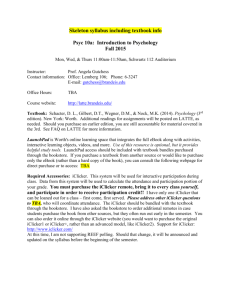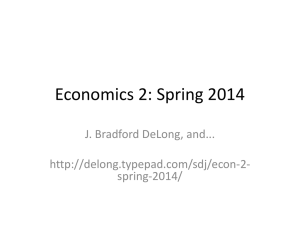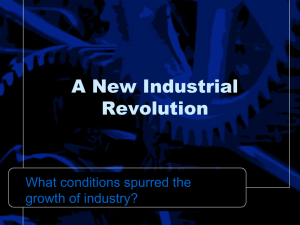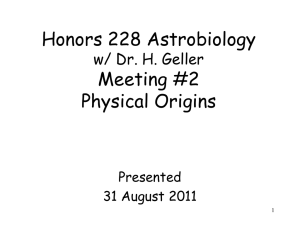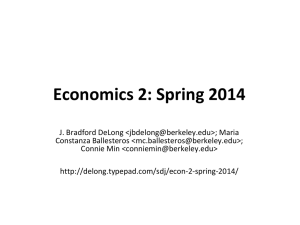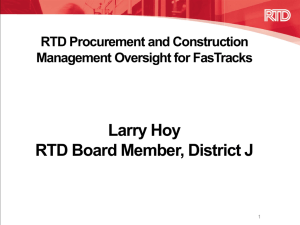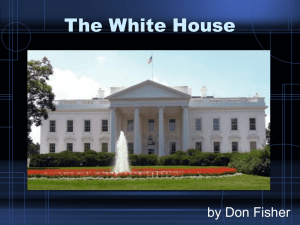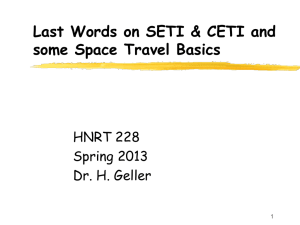Patterns of Energy Consumption
advertisement
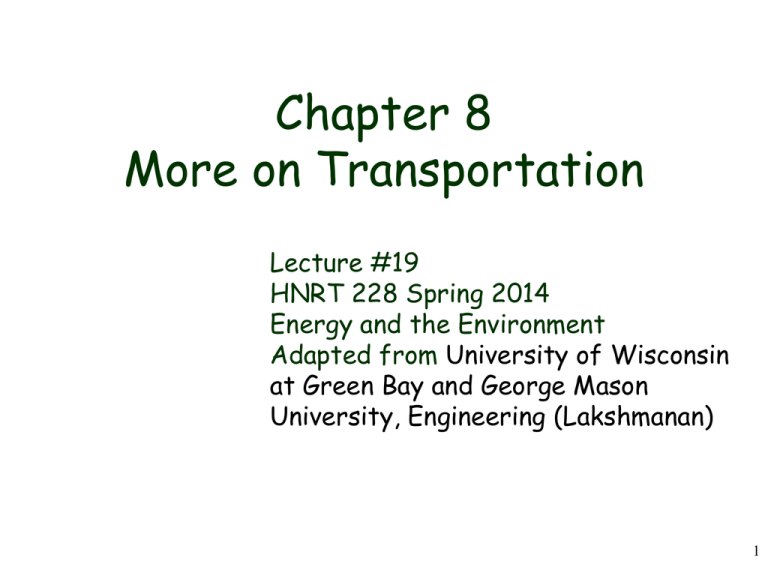
Chapter 8 More on Transportation Lecture #19 HNRT 228 Spring 2014 Energy and the Environment Adapted from University of Wisconsin at Green Bay and George Mason University, Engineering (Lakshmanan) 1 Remember Overview of Chapter 8 • Transportation – Power and Energy Batteries, flywheels, hybrids, hydrogen, alcohol – Traffic safety – The Automobile – Mass Transportation 2 iClicker Question What is the work output of a heat engine whose thermal energy input is 400 J and whose exhaust is 300 J? A 100 J B 200 J C 300 J D 400 J E 700 J Work output = Energy Input – Exhaust (or waste) Work output = 400 – 300 = 100 J 3 iClicker Question You have a heat engine whose thermal energy input is 400 J and whose exhaust is 300 J, what is the efficiency of this heat engine? A 175% B 75% C 50% D 33% E 25% Efficiency = work output / energy input = 100 / 400 = 25% 4 iClicker Question During each cycle of its operation, a certain heat engine does 40 joules of work while exhausting 160 joules of thermal energy to the environment. The energy efficiency of this heat engine is A 20% B 25% C 75% D 80% E None of the above. Energy efficiency = = = = Work output / Energy input 40 J / (40 J + 160 J) 40 J / 200 J 20% Please do not forget that the energy input = work output + exhaust [because of the conservation of energy] 5 iClicker Question A 2000 N car travels 50 m along a level road, powered by a drive force of 1000 N. The work done by the drive force is A 5000 J B 1000 J C 2000 J D 50,000 J E 10,000 J W = F x d = (1000 N) x (50 m) = 50,000 J 6 iClicker Question • What does HEV stand for? – A High Efficiency Vehicle – B Heavy Economy Vehicle – C Hybrid Electric Vehicle – D High-voltage Electric Vehicle – E High Energy Vehicle 7 iClicker Question • Which of the following does not increase fuel efficiency? – A Properly inflated tires – B Proper oil used – C Weight of cargo – D Driving faster – E Lighter weight vehicle 8 iClicker Question • What does CAFE stand for? – A Combined Average Fuel Economy – B Corporate Average Fuel Economy – C Composite Average Fuel Economy – D Calculated Average Fuel Estimate – E Corporate Average Fuel Estimate 9 Transportation Time Through the Centuries 1700 1800 1900 2000 Travel across Atlantic Weeks Weeks Days Hours Travel across U.S. Months Months Days Hours Communication across Atlantic Weeks Weeks “Instant” “Instant” 10 Inventions 1800-1900 • • • • • • • • • Steamship, 1807 Telegraph 1837 Automobile 1884 Bicycle 1885 Camera (film) 1888 Dynamite 1866 Dynamo 1871 Elevator, 1852 Electric Iron 1882 • • • • • • • • • Electric Motor 1837 Phonograph 1877 Typewriter 1867 Welding 1877 Sewing Machine 1846 Light Bulb 1879 Telephone 1876 Blast Furnace 1856 Electric Stove 1896 11 Overcoming limitations • • Limitations of Space – Distance Limitations of Time – Food Preservation – Communications – Lighting – Rapid Production – Growth of Leisure 12 Lighting in Early 1800's • • • Coal + Heat => Coking Coking, originally developed on a large scale for steel making, gives off – Liquid Fuels – Gases Coking gases lead to piped gas Lamps. – Demand for gas soon leads to a gas industry in its own right 13 Lighting into the 1900s • • • • 1830 Whale Oil – Except in cities, America too dispersed for piped gas. Need for portable high-quality fuel answered by whale oil. 1860 Kerosene Lamp – Kerosene developed as a substitute for increasingly scarce whale oil. 1876 Electric Light 1920 Bulb-blowing Machinery – Brought light bulbs down in cost from dollars to pennies. One of the oldest unchanged mass-production devices. 14 Social Impact of Lighting • Community life – – • More Effective Use of Leisure Time – – • • Safer to go out at night Places to go theaters, social gatherings, etc. Easier to Read Adult Education for Working Classes Demand for more Leisure Time Loss of ability to view night sky 15 The Role of Communications • • You can’t have skyscrapers without telephones Mail delivery financed transportation technology – – – Humans, humans on horses, horse drawn carriages Railroads, 19th Century Air Travel, 20th Century 16 Effects of Overcoming Space and Time • • Faster transportation leads to – More Leisure Time – More Effective Use of Leisure – More Experiences Space = Time if you have to move slowly – Railroad (Bulk Transport) – Personal Transportation – Air (Personal and Cargo) 17 Transportation Using Canals • • • • Early 1800's Canals in England 1825 Erie Canal: Access to Great Lakes and West 1856 Soo Canals: Iron to feed U.S. steel industry The age of canals was short and canals don't look very impressive on the map, but they were a critical link in transportation history 18 Transportation by Railroad • • • • • • 1800 Prototypes in Mines 1829 Manchester-Liverpool, England 1835 1000 Miles in US 1840 3000 Miles in US 1860 30,000 Miles in US 1869 Transcontinental 19 Effects of the Railroad • • • Opening of Markets Rise of Consumer Goods Exploitation of European Colonies -but– Led to Third World (especially India) Rail Systems 20 Travel Time in the USA, 1800 21 Travel time in the USA, 1830 22 Travel time in the USA, 1857 23 iClicker Question • In 1800 what was the average time to go from New York to Chicago? – A 1 day – B 1 week – C 2 weeks – D 3 weeks – E over 4 weeks 24 iClicker Question • In 1857 what was the average time to go from New York to Chicago? – A 1 day – B 2 days – C 5 days – D 7 days – E 2 weeks 25 iClicker Question • What was the major transportation change that lowered the time taken to go from New York to Chicago between 1800 and 1857? – A the development of canals – B the invention of the wheel – C the horse drawn carriage – D the automobile – E the railroad 26 Where the Rails Met 27 28 Union Pacific Cut 29 The Rival Routes 30 What Happened to the Rails 31 Not Far Away… 32 Travel times in the USA, 1930 33 Effects of Overcoming Space/Distance • • • Manufacturer – Access to Raw Materials Seller – Access to Markets Consumer – Access to Goods 34 Urban Sprawl • • • • • Steamboat suburbs, 1830’s Railroad suburbs by 1850’s “Commuter“ - 1865 Planned suburbs, late 1800’s Streetcars and Interurban railroads 35 After World War II, there was an enormous spread of suburban growth. The sequence of growth was one of radial expansion along urban expressways, followed by a filling-in of the areas between them. Freeways and beltways fostered the development of suburban centers that competed with the central business district as places of employment and locations for commercial, financial, and professional services. 36 During the mid-1800’s, urban growth spread along the radial routes of the early streetcars. Residential growth spread northward along Lake Michigan and to the northwest. The lines of urban expansion set the initial structure for the development of metropolitan Chicago. 37 The introduction of the electric streetcar reinforced the radial pattern of growth for the city. By 1900, the radial patterns were less pronounced as a result of residential growth in the interstitial areas. 38 Wisconsin Interurban Railroads 39 Midwest Interurban Railroads 40 Interurban Rail, Los Angeles 41 Los Angeles Streetcar Lines 42 Los Angeles doesn’t sprawl because it has freeways -Los Angeles built freeways because it sprawls 43 iClicker Question • Urban sprawl began after World War II. – A True – B False 44 iClicker Question • The automobile was the major cause of urban sprawl. – A True – B False 45 The Downside of Light Rail • • • • Lines were very unprofitable Owners invested in real estate Sometimes built amusement parks at the end of the line Lines frequently serviced owners’ developments and bypassed others 46 If You Think Cars Pollute, Consider Horses • • • • New York City generated thousands of tons of horse manure a day Horses often cruelly overworked 15,000 horses a year died on the streets of New York each year Many were just abandoned 47 Roads • • 1790: Nicolas Cugnot, prototype steam carriage 1800’s: Thomas Telford – – – Old-style roads damaged by wheels Well-graded roads damaged by horses’ hooves By 1830’s, Britain had road system better than the Roman Empire 48 More on Roads • • • • • Telford advocated steam carriages to reduce wear on roads Prototypes actually ran in 1830’s Stiff opposition from stagecoach operators, who held mail contracts Stagecoach operators eventually eclipsed by railroads Delayed advent of auto by half century 49 Personal Transportation • • • Bicycle: toy for rich in 1830’s Fully modern design by 1880’s First true personal transportation – – • Not bound by streetcar routes Doesn’t need to be fed Pioneered mass production technology and metallurgy for automobile 50 Another Technological Spiral 51 George B. Selden “Inventor” of the Automobile • • • • • Foresaw mechanized transport coming Took out a patent in 1879 on a largely imaginary “road engine” Delayed issuance of the patent for 16 years (1895) Collected royalties for 17 years despite doing nothing for the technology Selden’s gimmick led to reforms in patenting 52 1883 Stationary Gas Engine 53 Early Motorcycle, 1885 54 1889 Daimler Auto 55 1902 Daimler Roadster 56 Mercedes Jellinek 57 iClicker Question • Daimler invented the automobile. – A True – B False 58 World War I • • • Railroads insufficient for Army’s needs Army turned to truck convoys Civilians found convoy routes featured innovations – – – Route Markings Regular Maintenance Snow Removal 59 Pershing’s Map, 1922 60 The Interstate Highway System 61 World War II: The First High-Tech War First war whose outcome depended critically on simultaneous technological advances Radar Computers Missiles Jet Aircraft Nuclear Weapons 62 Post-War Political Changes Military-Industrial Complex Cold-War • • Post-War Lifestyle Changes • • Growth of Suburbs Professionalization – – GI Bill Growth of Universities Overtraining? Rise of Materialism Erosion of Family? • • 63 Much of Today's "High Tech" is an improvement on older "Low Tech.“ ------------------------------------------In many ways, the "Low Tech" advance was the real revolution Freeway vs. Railroad •Light Bulb vs. Gas Lamp •Internal Combustion or Electric Motor • vs. Steam • Automobile vs. Bicycle 64 The Rising Need for Mass Transportation 65 Urban Population in Industrial & Developing Regions, Selected Years Billion People 5 Industrial 4 Devloping 3 2 1 0 1950 1975 1995 2030 66 Rate and Scale of Population Growth in Selected Industrial Cities, 1875-1900, and Developing Cities, 1975-2000 Annual Population Growth (percent) Population Added (million) Industrial Cities (1875-1900) Chicago New York Tokyo London Paris 6.0 3.3 2.6 1.7 1.6 1.3 2.3 0.7 2.2 1.1 Developing Cities (1975-2000) Lagos Bombay São Paolo Mexico City Shanghai 5.8 4.0 2.3 1.9 0.9 10.2 11.2 7.7 6.9 2.7 City 67 68 69 Trends Affecting Transportation A. Economics and Society Concentration & Dispersal B. Rapid Urbanization & Explosion of Motorization C. Changing Nature of Travel D. Problems of Auto-dependent World Congestion Pollution Add to Global Climate Change Traffic Accidents Other Social Costs E. Implications for Mass Transportation 70 2,500 2,000 use of automobiles* 1,500 total popul ati on urban population 1,000 motor vehic le fl eet 500 0 1960 1970 1980 1990 2000 2010 71 Road Supply as a Percentage of Urbanized Areas City Road Space (%) Developing Countries Kolkata (India) Shanghai (Chin a) Bangkok (Thailand ) Seoul (S. Korea) Delhi (India) São Paulo (Brazil) 6.4 7.4 11.4 20.0 21.0 21.0 Developed Countries New York (US) London (UK) Tokyo (Japan) Paris (France) 22.0 23.0 24.0 25.0 72 Global Car Ownership, 1993 Region Cars/1000 pop South Asia Africa East Asia & Pacific Middle East Latin America & Caribbean Central & Eastern Europe OECD (excluding the US) US 3 14 29 45 68 72 366 561 73 Global Vehicle Ownership, Selected Countries Country GNP/capita Veh/1000 (US$) pop Japan US Germany France UK Australia S. Korea Brazil Malaysia Thailand The Philippines Indone sia Sri Lanka China India Vietnam 34630 24780 23980 23420 18340 18000 8260 4400 3140 2140 950 810 600 530 320 210 640 740 570 520 410 610 206 190 340 190 32 58 50 21 30 27 Priva te motorized ve hicles (%) MTW Cars Total 20 58 78 2 88 90 9 89 98 10 87 97 3 86 89 3 76 79 24 33 57 10 82 92 56 34 90 66 16 82 26 28 54 69 16 84 60 13 73 40 24 64 67 14 81 91 9 100 74 Daily Motorized Trips by Public & Private Transport, Selected Cities in Developing Countries Beij ing Bouake Rio Abdijan Santiago Col ombo Seoul Cai ro City Mexico city Public Private Buenos Ai res Pretor ia Dakar Lag os Car acas Doual a Sao Paulo Yaounde Bamako Hanoi Ouag adougou 0 20 40 60 % of Daily Trips 80 100 75 Trip Purpose, Selected Cities 25 34 Trip Purpose % School Work Other and School 50 75 25 18 52 48 44 46 45 39 36 41 29 3 19 20 32 34 Work City (country) Alger (Algeria) Bangkok (Thail and) Kolkata (India ) Delhi (India) Hanoi (Vietnam) Jakarta (Indonesia) Santiago (Chil e) São Paulo (Brazil) 73 77 64 59 68 75 28 25 36 41 32 25 76 Door to Door Travel Times, all Modes, São Paulo, 1997 Mode Train Subway Bus Minibus 1 Auto Taxi 2 Motorcycle Bik e Foot (1) illegal paratransit source: CMSP, 1998 Door-to-door tavel time (m in) (including transfers) 93 77 56 37 28 26 25 23 15 (2) individual use only 77 Car and Bus Travel Times Travel Times (min) Bus Car Ratio City (Country) bus/car Alger (Algeria), 1990 56 30 1.9 Caracas (Venezuela), 1982 54 36 1.5 Mexico City (Mexico), 1994 50 35 1.4 São Paulo (Brazil), 1997 56 28 2 (a) door-to-door travel times, average for all trips 78 Traffic Fatalities and Rates, Selected Countries Country Fatalities Fatalities/ Developed US, 1995 France, 1984 Germany, 1984 Japan, 1984 Developing India, 1996 Chin a, 1994 Brazil, 1995 S. Korea, 1995 S. Afr ica, 1992 Nigeria, 1980 Thailand, 1992 Poland, 992 Mexico, 1994 Bagladesh, 1992 Czech Republi c, 1997 /year 10,000 veh Fatalities/ 100,000 pop 41,798 11,685 10,199 9,262 3 6 4 2 16 21 16 8 69,800 66,322 27,886 10,323 10,142 8,936 8,184 6,946 5,115 2,317 1,600 21 82 11 12 18 141 9 6 4 61 4 8 6 17 23 32 13 14 18 5 2 15 79 Pedestrian Fatalities as a Percentage of Total Traffic Fatalities, Several Regions Region Europe/ US Latin America Afr ica Middl e East Asia Pedestrian Fatalities (% of total) 20 60 45 51 42 80 Transportation History Summary ~ The Horse Car Era (1840-90) ~ The Electric Street Car (1890 – 1920) ~ Interurban & Suburban Railroads (1900-1930) ~ Expressways & Beltways (1950 + ) 81 Post World War II Transit ~ The Interstate Program ~ Home Mortgage Subsidy Program ~ The G. I. Bill ~ The Parking Policies ~ Increasing Female Labor Force Participation ~ The Decline of Transit ~ Public Support of Transit 82 Five major tends in public transit ridership are evident since 1900. A period of initial growth between 1890-1920, followed by a period of fluctuation between 1920-1939 during which an initial growth in ridership gave way to a decline during the Great Depression years. This loss in ridership was offset by dramatic growth during the war years 1940-1945. Ridership declined dramatically from 1946-1972 with the rapid suburbanization of metropolitan areas and a public preference for the automobile. The years from 1972 to the present have seen a modest increase in ridership as a result of growing awareness and support for alternatives to the automobile. 83 Share of Transit Trips in Large Metropolitan Areas, All Modes (a), and Rail Modes only (b), 1993. 84 Car Ownership Rate in Selected Countries, 1970-92 (number of cars per thousand persons) 85 Transportation Indicators in Selected Cities, by Regional Average, 1990 Commute to Work Region United States Australia Canada Western Europe Developing Asia Wealthy Asia Driving 86.4 80.4 74.1 42.8 38.4 20.1 Public Transport percent) 9.0 14.5 19.7 38.8 35.7 59.6 Walking/Cycling 4.6 5.1 6.2 18.4 25.8 20.3 86 Public Transportation A. Formal and Informal Bus and Other Services - Decline of Large Bus Operations municipal and large by systems fare control, investment declines, poorer service corruption and political control failures: Lagos State Transportation Corporation Pakistan Road Transport Corporation Central Transport Board - Para Trasit Services B. Urban Transit Options - Technology - Operational Form - Amenity Levels - Management Form - Costs 87 Characteristics of Selected Light Rail Transit Systems Ci ty Bogata Hong Kong Tuen Mu n Istanbu l Man ila Medel l i n Me xico Ci ty Tren le ger Rio Li ne 2 Tu n is Right-of-way: ele vated elv un de rgroun d: u/g Len gth Station spaci ng Min imu m he adway at grade: a/g km km Min:sec Elevated At grade 50.0 23.0 1.0 0.6 5.00 1.00 Part u/g part a/g Elevated Elevated Part a/g part elv 24.0 14.0 32.0 11.0 1.3 1.2 1.3 - Part u/g part a/g At grade 22.0 10.0 1.6 0.8 C ars pe r trai n Hourly design capaci ty Average journe y speed p/h/d kmph 1/2 14,000 26 1:30 2:00 2:30 - 3/4 2 6 - 28,000 25,000 - 28 28 - 1:00 2 2 24,000 19 88 Performance of Public and Private Bus Operators Bus Operator Performance Indicators (ranges) Public Average fleet availability (%) 47-85 Passengers per bus daily 1200-2200 Passengers per km operated 7.6-10.1 Daily km per bus operated 160-220 Staff per bus operated 5.8-13.5 Load factor 0.3-0.6 Profitability (revenue: cost) 0.6-1.2 Private 80-89 200-2900 1.2-12.1 170-240 1.0-3.7 0.6-0.9 0.9-3.6 89 http://www.vamoosebus.com/pages/gold.aspx 90 SUCCESSFUL CASE STUDIES IN PUBLIC TRANSPORTATION Adaptive Cities Industrialized Countries - Portland, Oregon - San Diego, California Developing Countries Curitiba, Brazil Mexico City Adaptive Transit (Tailoring Transit to Serve Cities & Suburbs) - Technology - based Solutions (Karlsruhe, Germany) - Service Innovations (Adelaide, Australia) - Small Vehicle & Private Services 91 Portland, A Transit Metropolis Favorable Factors - Metropolis Governance Farsighted Comprehensive Plan Prosperous & Growing CBD Urban Growth Boundaries Parking Policies Proactive Station Planning Process MAX (Metropolitan Area Extension) - Density Considerations - Public Policy & Market Needs 92 Issues and Guiding Principles in Urban Transit Planning Three underlying objectives: 1. Plan to serve requirement of a metro region involved in globalization processes vital to economic sustainability 2. Plan Framework must aim at equitable access to all including poor (to overcome public policy regimes typically favoring private motor transport). 3. Plan must promote environmental quality and safety. 93 General Principles and Guidelines 1. Mode Complementarity Principle 2. Innovations in Public Transport Mode 3. Economic and Financial Sustainability 4. Land Development and Land Use Guidance 5. Improving Personal Safety 6. Environmental Sustainability 7. Design of a Governance Structure (Institutional Capacity) 94 Mode Complementarity Principle Different Transit Modes Vary in: • • • • • • cost speed seating capacity flexibility other performance characteristics broad ‘regimes’ where mode has advantages over others 95 Mode Complementarity Principle continued View an urban passenger trip as an ‘intermodal’ trip coordinating modes seamlessly from point A to point B A functional combination of ‘heavy’, ‘medium’ and ‘light’ modes This will reduce the fragmentation of metro population into different locations with different incomes and access potentials 96 Innovations in Public Transport Modes A core mode of a multi tier metro hierarchical network of transit Modes which (a) provides accessibility services to entire metro Region and (b) is crucial in restraining the use of a private car. Choices: 1. Underground transport or elevated system US$ 100 million/km 2. Busway Systems with a network of feeder buses, special loading platforms, business centers US$ 1-3 million/km (up to 25,000 passengers/hr/direction. Curitiba, Bogota, São Paulo) 97 Economic and Financial Sustainability Key Issues: Bus or Paratransit (charette) Productivity Cost Recovery and Fare System Financing Incentives Externality Changes (congestion, pollution, etc.) Demand Management 98 Bus Productivity a Function of: Passenger - km traversed/day Salary Levels Employees/bus 5 in private Brazilian buses, 11.5 in Mumbai (India) & 28 in Accra (Ghana) Fare setting & Income Levels Pricing Externality 99
